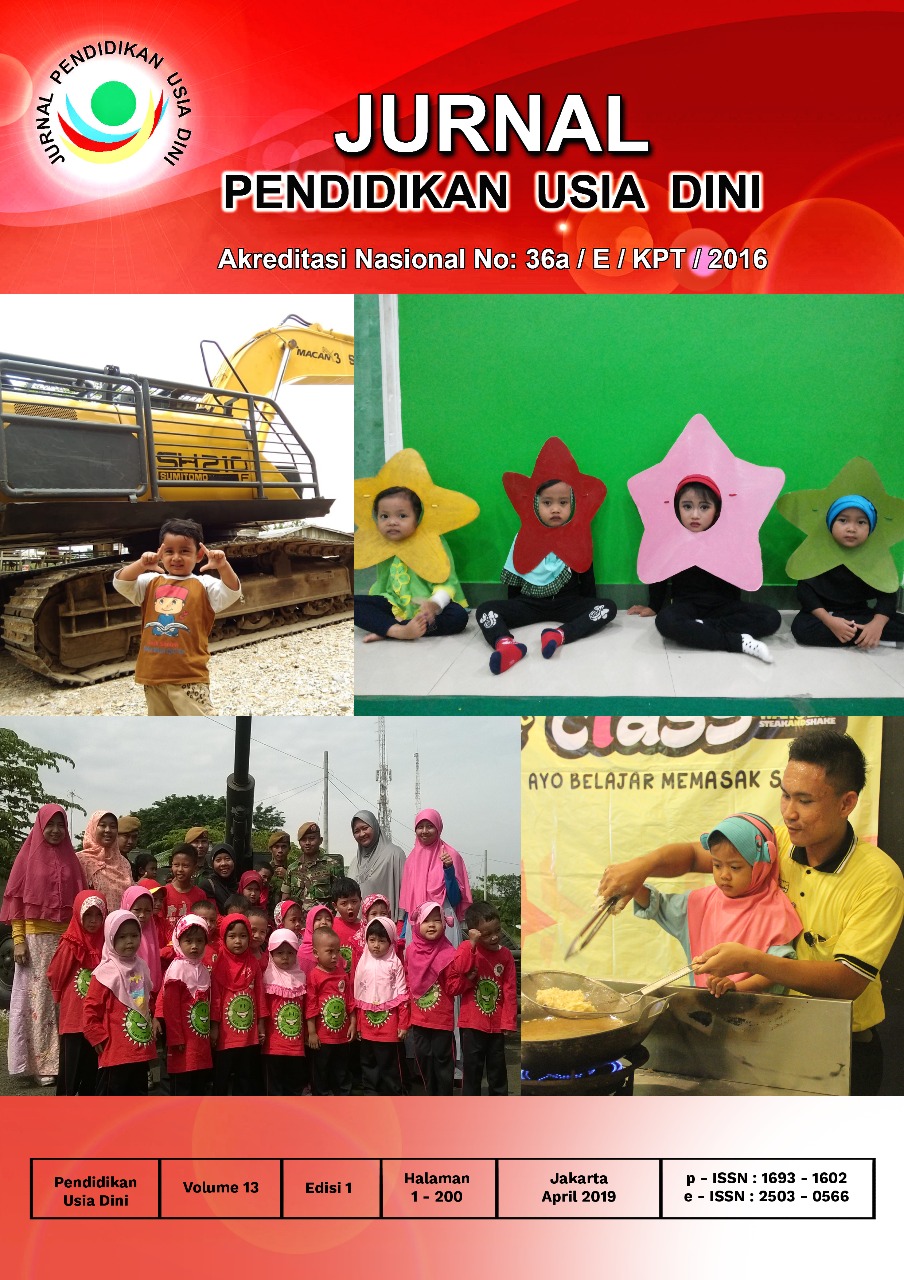The Effectiveness of Using Mind Mapping Method to Improve Child Development Assessment
DOI:
https://doi.org/10.21009/10.21009/JPUD.131.13Abstract
This study aims to determine the effectiveness of using mind mapping method in improving early childhood educator’s skill in mastering the child development assessment. This research is quasi-experimental using a pre-test and post-test design. The population was the entire classes of early childhood education training held by LPK Yayasan Indonesia Mendidik Jaka Sampurna at Cileungsi, Bogor. The participants were 45 early childhood educators. This study used three research methods which are implemented from learning methods in child development assessment was as pre-test and post-test. Data were collected by using two instruments to measure early childhood educators for child development assessment. The data were analyzed by using t-test to measures the differences data in pre-test and post-test. The results showed that the use of mind mapping methods can help early childhood educators to improve their mastery of the development assessment concept which averages 51.9 percent. It showed significant results with t-test value is 18,266 (N = 10, α = 0,0). This capacity build-ing is reinforced by various qualitative findings which arise from early childhood educators’ awareness to change the old learning style into learning by mind mapping method as a learn-ing method that follows how the brain works. This study also found that early childhood educators as adults who are in the stage of formal thinking have shown an understanding that mind mapping method are appropriate, fast, easy and practical in mastering various devel-opment assessment concepts. Early childhood educators believe that they can use the method for mastering other material concepts.
Keywords: Assessment, Brain-based teaching, Mind mapping
References
Anthony, J. N. (2001). Educational Assesment of Student. New Jersey: Merril Prentice Hall.
Armstrong, T. (2009). Multiples Intelligences in the Classroom. Virginia: SCD.
Bagnato, S. J. (2007). Authentic Assessment for Early Childhood Intervention. New York: The Guilford Press.
Bellman, M., & Byrne, O. (2013). Developmental assessment of children, (January), 4–9. https://doi.org/10.1136/bmj.e8687
Blessing, O. O., & Olufunke, B. T. (2015). Comparative Effect of Mastery Learning and Mind Mapping Approaches in Improving Secondary School Students’ Learning Outcomes in Physics. Science Journal of Education, 3(4), 78–84.
Bowman, B. T., Donovan, M. S., & Burns, M. S. (2001). Eager to Learn. Eager to Learn. Washington DC: NAtional Academy Press. https://doi.org/10.17226/9745
Bricker, D., & Squires, J. (1999). Ages and stages questionnaires: A parent completed, child-monitoring system (2nd editio). Baltimore, MD: Brookes Publishing.
Buzan, T. & Buzan, B. (1996). The mind map book: How to use radiant thinking to maximize your brain’s untapped potential. New York: Plume.
Buzan, T. (1974). Use Your Head. Innovative Learning and Thinking Techniques to Fulfil Your Mental Potential. BBC books.
Choo, Y. Y., Yeleswarapu, S. P., How, C. H., & Agarwal, P. (2019). Developmental assessment: practice tips for primary care physicians. Singapore Medical Journal, 60(2), 57–62. https://doi.org/10.11622/smedj.2019016
DIKMAS, D. (2015). Pedoman Penilaian Hasil Pembelajaran. Jakarta, Indonesia.
Feeney, S. D. C., & Moravcik, E. (2006). Who Am I in The Live Of Children. New Jersey: Pearson Merill Prentice Hall.
Gall, M. D., Gall, J. P., & Borg, W. R. (2007). Educational Research: An Introduction (4th ed.). New York: Longman Inc.
Goel, P. S., & N. Singh. (1998). Creativity and innovation in durable product development. Computers & Industrial Engineering, 35(1–2), 5–8. https://doi.org/http://dx.doi.org/10.1016/S0360- 8352(98)00006-0
Hartati, S. (2012). Tingkat Pengetahuan Guru TK tentang Asesmen Perkembangan Anak Usia Dini di TK Kelurahan Rawamangun, DKI Jakarta. Jakarta.
Indonesia, D. P. dan K. Menteri Pendidikan dan Kebudayaan, Pub. L. No. No. 146 (2014). Indonesia.
Jensen, E. (2008). Brain-Based Learning. Pembelajaran Berbasis Kemampuan Otak. Yogyakarta: Pustaka Pelajar.
Jones, B. D., Ruff, C., Tech, V., Snyder, J. D., Tech, V., Petrich, B., … Koonce, C. (2012). The Effects of Mind Mapping Activities on Students ’ Motivation. International Journal for the Scholarship of Teaching and Learning, 6(1).
Kostelnik, M. J., Soderman, A. K., & Whiren, A. P. (2007). Developmentally Approriate Curriculum, Best Practice In Early Childhood Education. New Jersey: Pearson Education Inc.
Lienhard, D. A. (n.d.). Roger Sperry ? s Split Brain Experiments ( 1959 ? 1968 ). The Embryo Project Encyclopedia.
Meisels, S. J. (2001). Fusing assessment and intervention: Changing parents’ and providers’ views of young children. ZERO TO THREE, 4–10.
NAEYC. (2003). Early Childhood Curriculum, Assessment, and Program Evaluation.
Riswanto, & Putra, P. P. (2012). The Use of Mind Mapping Strategy in the Teaching of Writing at SMAN 3 Bengkulu , Indonesia. International Journal of Humanities and Social Science, 2(21), 60–68.
Sandy, M. G. (1992). Pice of Mind. Jakarta: Gramedia Pustaka Utama.
Slentz, K. L. (2008). A Guide to Assessment in Early Childhood. Washington: Washington State.
Suyadi, S. (2017). Perencanaan dan Asesmen Perkembangan Pada Anak Usia Dini. Golden Age: Jurnal Ilmiah Tumbuh Kembang Anak Usia Dini, 1(1), 65–74. Retrieved from http://ejournal.uin-suka.ac.id/tarbiyah/index.php/goldenage/article/view/1251
Thomas, H. S. (2007). Today’s topics on creativity engineering system division. Massachusetts.
Thornton, S. (2008). Understanding Human Development. New York: Palgrave, Macmillan.
Windura, S. (2013). Mind Map Langkah Demi Langkah. Jakarta: Elex Media Computindo.
Wortham, S. C. (2005). Assesment in Early Childhood Education. NewJersey: Pearson.
Wycoff, J. (1991). Mindmapping: Your Personal Guide to Exploring Creativity and Problem-Solving. Berkley; Reissue edition.
Yunus, M. M., & Chien, C. H. (2016). The Use of Mind Mapping Strategy in Malaysian University English Test (MUET) Writing. Creative Education, 76, 619–662.
Downloads
Published
How to Cite
Issue
Section
License
JURNAL PENDIDIKAN USIA DINI work is licensed under a Creative Commons Attribution 4.0 International License. (http://creativecommons.org/licenses/by/4.0/)





